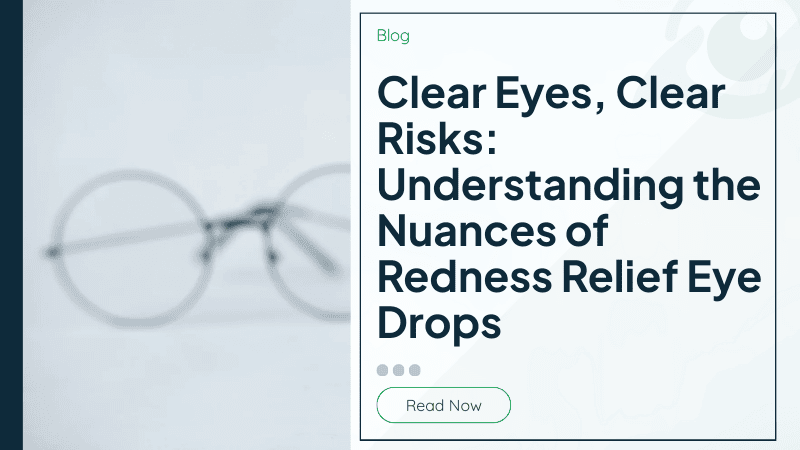- About
- Services
- Conditions
- Pricing
- Book an Eye Exam

Red, irritated eyes are a common discomfort, and many turn to over-the-counter redness relief eye drops for quick relief. Products like Visine, Clear Eyes, and numerous generic options are often seen as a quick fix, a simple solution for clearer, less irritated eyes. However, while these drops may offer immediate cosmetic benefits, their long-term impact and effectiveness warrant a closer look.
Most redness relief eye drops contain vasoconstrictors like tetrahydrozoline or naphazoline. These ingredients function much like traffic controllers in the bustling streets of a city, which in this metaphor, are the blood vessels in your eyes. These vessels transport vital supplies such as oxygen and nutrients. Vasoconstrictors narrow these 'streets' to reduce the appearance of redness, but this effect is merely a temporary solution.
One significant concern with these eye drops is the phenomenon known as rebound redness. Initially, these drops reduce redness by narrowing the blood vessels. However, with prolonged use, they can lead to an opposite effect. Once the drops wear off, the blood vessels can dilate more than before, causing even more pronounced redness. This cycle can be likened to a roller coaster, where the highs and lows of usage leave the eyes in a worse state than before.
Redness in the eyes can be a symptom of various conditions, including allergies or systemic health issues. By merely masking this redness, these eye drops can lead to a delay in diagnosing and treating underlying problems. It's akin to a magician's illusion, where the trick conceals the reality without addressing the root cause.
Another concern is the potential for these drops to disrupt the natural balance of tears, leading to dry eye syndrome. This condition is marked by insufficient or poor-quality tear production, leading to discomfort, blurred vision, and light sensitivity.
The use of these eye drops can also lead to side effects such as irritation, burning, or stinging sensations. In some cases, systemic absorption of the vasoconstrictor can occur, which might lead to increased blood pressure and heart rate, posing risks for those with cardiovascular conditions. Allergic reactions, though less common, can also occur, manifesting as redness, swelling, itching, or more severe symptoms.
Optometrists often recommend preservative-free artificial tears as a safer alternative. These lubricating drops work by supplementing the eye's natural tear film, providing relief without the risks associated with vasoconstrictors.
For persistent eye redness, irritation, or dryness, it's essential to consult with an optometrist. A comprehensive eye examination can help identify the root causes of these symptoms. Optometrists can tailor a treatment plan specific to each patient's needs, addressing the underlying issues rather than just the symptoms.
When choosing eye drops, it's crucial to understand the ingredients and their functions. Educating oneself about the different types of eye drops available can help in making informed decisions about eye care. Over-the-counter eye drops, while readily available, should be used as directed. Misuse or overuse can lead to complications, emphasizing the importance of adhering to the recommended usage guidelines.
In addition to proper medication, lifestyle adjustments can play a significant role in maintaining eye health. This can include managing screen time, ensuring adequate hydration, and protecting the eyes from environmental factors like wind and UV rays. A balanced diet rich in vitamins and nutrients can also support ocular health. Foods high in omega-3 fatty acids, vitamin A, and antioxidants can contribute to healthier eyes and may reduce the risk of chronic eye conditions.
In summary, while redness relief eye drops can provide temporary cosmetic relief, they should be used with caution. Understanding the risks, exploring safer alternatives, and consulting with an optometrist for persistent issues is crucial. A holistic approach, combining proper medication, lifestyle changes, and a healthy diet, can ensure long-term eye health and clarity. Remember, clear eyes require more than just drops; they demand a comprehensive care strategy.
Book your comprehensive eye exam in Calgary with Eye Check Calgary. Whether it’s digital eye strain, dry eyes, diabetes-related vision concerns, or a contact lens fitting, we’ll guide you through every step with care and clarity. Call us today at 587-441-5254.